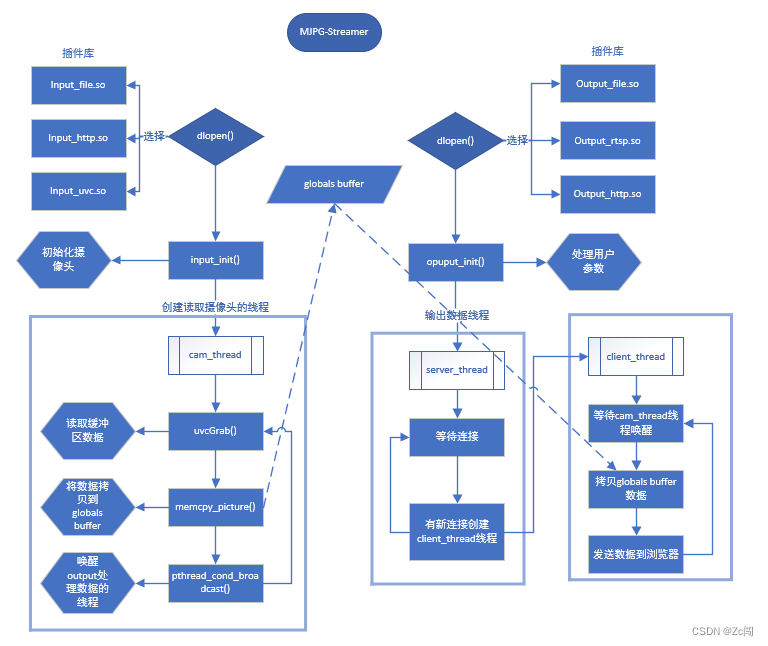MJPG-Streamer介绍
MJPG-Streamer是个JPEG的文件传输流,应用于Linux系统,通过v4l2读取相机图像,之后通过http发送到客户端浏览器。
MJPG 的优点
很多摄像头本身就支持 JPEG、MJPG,所以处理器不需要做太多处理。
一般的低性能处理器就可以传输 MJPG 视频流。
MJPG 的缺点
MJPG 只是多个 JPEG 图片的组合,它不考虑前后两帧数据的变化,总是传输一帧完整的图像,传输带宽要求高。
H264 等视频格式,会考虑前后两帧数据的变化,只传输变化的数据,传输带宽要求低
MJPG-Streamer整体架构
MJPG-Streamer采用插件的方式扩展功能,不需要的功能可以不进行加载

代码详细分析
重要数据结构
全局数据,存储抽象出的input对象和output对象
struct _globals {
int stop;
/* input plugin */
input in[MAX_INPUT_PLUGINS];
int incnt;
/* output plugin */
output out[MAX_OUTPUT_PLUGINS];
int outcnt;
/* pointer to control functions */
//int (*control)(int command, char *details);
};
input结构体,将读取数据的操作抽象成此结构体
buf存放数据,context根据不同的插件为不同结构体,init、stop等为操作函数
typedef struct _input input;
struct _input {
char *plugin;
char *name;
void *handle;
input_parameter param; // this holds the command line arguments
// input plugin parameters
struct _control *in_parameters;
int parametercount;
struct v4l2_jpegcompression jpegcomp;
/* signal fresh frames */
pthread_mutex_t db;
pthread_cond_t db_update;
/* global JPG frame, this is more or less the "database" */
unsigned char *buf;
int size;
/* v4l2_buffer timestamp */
struct timeval timestamp;
input_format *in_formats;
int formatCount;
int currentFormat; // holds the current format number
void *context; // private data for the plugin
int (*init)(input_parameter *, int id);
int (*stop)(int);
int (*run)(int);
int (*cmd)(int plugin, unsigned int control_id, unsigned int group, int value, char *value_str);
};
output结构体,将发送数据操作抽象成此结构体
buf存放数据,context根据不同的插件为不同结构体,init、stop等为操作函数
typedef struct _output output;
struct _output {
char *plugin;
char *name;
void *handle;
output_parameter param;
// input plugin parameters
struct _control *out_parameters;
int parametercount;
int (*init)(output_parameter *param, int id);
int (*stop)(int);
int (*run)(int);
int (*cmd)(int plugin, unsigned int control_id, unsigned int group, int value, char *value_str);
};
插件加载
插件加载示例:
./mjpg_streamer -i "./input_uvc.so -y" -o "./output_http.so -w ./www" -o "./output_file.so -f /www/pice -d 15000"
代码处理
所有命令:
static struct option long_options[] = {
{"help", no_argument, NULL, 'h'},
{"input", required_argument, NULL, 'i'},
{"output", required_argument, NULL, 'o'},
{"version", no_argument, NULL, 'v'},
{"background", no_argument, NULL, 'b'},
{NULL, 0, NULL, 0}
};
获取命令,获取到是-o还是-i等命令
c = getopt_long(argc, argv, "hi:o:vb", long_options, NULL);
不同命令不同处理方式,optarg表示参数,对于示例-i的参数就是:“./input_uvc.so -y”
switch(c) {
case 'i':
input[global.incnt++] = strdup(optarg);
break;
case 'o':
output[global.outcnt++] = strdup(optarg);
break;
case 'v':
printf("MJPG Streamer Version: %s\n",
#ifdef GIT_HASH
GIT_HASH
#else
SOURCE_VERSION
#endif
);
return 0;
获取要加载的插件(动态库)名称,之后通过dlopen函数将其加载到内存,并返回句柄
tmp = (size_t)(strchr(input[i], ' ') - input[i]);
...
global.in[i].plugin = (tmp > 0) ? strndup(input[i], tmp) : strdup(input[i]);
global.in[i].handle = dlopen(global.in[i].plugin, RTLD_LAZY);
将刚刚加载的插件中名为"input_init"的函数指针赋值给global.in[i].init,其他同理
global.in[i].init = dlsym(global.in[i].handle, "input_init");
...
global.in[i].stop = dlsym(global.in[i].handle, "input_stop");
...
global.in[i].run = dlsym(global.in[i].handle, "input_run");
...
global.in[i].cmd = dlsym(global.in[i].handle, "input_cmd");
初始化并运行input插件
global.in[i].init(&global.in[i].param, i));
...
global.in[i].run(i);
input_uvc分析
cam_thread线程中运行uvcGrab函数,将缓冲区的数据提出并拷贝到input.buf中
在init_v4l2函数中,将摄像头的缓冲区映射到mem数组中
vd->buf.index = i;
...
vd->mem[i] = mmap(0 /* start anywhere */ ,
vd->buf.length, PROT_READ | PROT_WRITE, MAP_SHARED, vd->fd,
vd->buf.m.offset);
出缓冲区
ret = xioctl(vd->fd, VIDIOC_DQBUF, &vd->buf);
将数据拷贝到vd->tmpbuffer里
memcpy(vd->tmpbuffer, vd->mem[vd->buf.index], vd->buf.bytesused);
入缓冲区
ret = xioctl(vd->fd, VIDIOC_QBUF, &vd->buf);
如果未定义NO_LIBJPEG,通过compress_image_to_jpeg函数,将vd->tmpbuffer中的数据压缩成JPEG后拷贝到pglobal->in[pcontext->id].buf里面
#ifndef NO_LIBJPEG
if ((pcontext->videoIn->formatIn == V4L2_PIX_FMT_YUYV) ||
(pcontext->videoIn->formatIn == V4L2_PIX_FMT_UYVY) ||
(pcontext->videoIn->formatIn == V4L2_PIX_FMT_RGB24) ||
(pcontext->videoIn->formatIn == V4L2_PIX_FMT_RGB565) ) {
DBG("compressing frame from input: %d\n", (int)pcontext->id);
pglobal->in[pcontext->id].size = compress_image_to_jpeg(pcontext->videoIn, pglobal->in[pcontext->id].buf, pcontext->videoIn->framesizeIn, quality);
/* copy this frame's timestamp to user space */
pglobal->in[pcontext->id].timestamp = pcontext->videoIn->tmptimestamp;
} else {
如果定义了NO_LIBJPEG,将vd->tmpbuffer中的数据直接拷贝到pglobal->in[pcontext->id].buf里面
pglobal->in[pcontext->id].size = memcpy_picture(pglobal->in[pcontext->id].buf, pcontext->videoIn->tmpbuffer, pcontext->videoIn->tmpbytesused);
compress_image_to_jpeg函数
通过jpeglib库,完成对图片的压缩
核心结构体
struct jpeg_compress_struct cinfo;
压缩流程
dest_buffer:将buffer赋值到cinfo->dest中的outbuffer和outbuffer_cursor里
jpeg_set_quality:设置质量
jpeg_start_compress:开始转换
line_buffer:存储rgb每个的数值的数组
jpeg_write_scanlines:写一行的rgb数据
jpeg_finish_compress:结束,保证同步
jpeg_destroy_compress:释放cinfo资源
int compress_image_to_jpeg(struct vdIn *vd, unsigned char *buffer, int size, int quality)
{
...
dest_buffer(&cinfo, buffer, size, &written);
...
jpeg_set_defaults(&cinfo);
jpeg_set_quality(&cinfo, quality, TRUE);
jpeg_start_compress(&cinfo, TRUE);
...
row_pointer[0] = line_buffer;
jpeg_write_scanlines(&cinfo, row_pointer, 1);
...
jpeg_finish_compress(&cinfo);
jpeg_destroy_compress(&cinfo);
free(line_buffer);
return (written);
}
output_http分析
server_thread线程
server_thread线程绑定ip和端口,创建监听,并加入到select;当有连接时,创建client_thread线程处理
getaddrinfo:对多个输入的网络参数进行处理,结果存储在aip结构体中
pcontext->sd[i]:监听描述符
setsockopt:设置端口复用
bind:绑定ip和端口号
listen:监听
select:io复用,当监听套接字有连接时,接触阻塞,selectfds结构体中存放接入连接的套接字
accept:接收连接,返回通信的套接字
最后创建通信的线程,将用于通信的相关参数传入
getaddrinfo(pcontext->conf.hostname, name, &hints, &aip)
...
pcontext->sd[i] = socket(aip2->ai_family, aip2->ai_socktype, 0)
setsockopt(pcontext->sd[i], SOL_SOCKET, SO_REUSEADDR, &on, sizeof(on))
...
bind(pcontext->sd[i], aip2->ai_addr, aip2->ai_addrlen)
...
listen(pcontext->sd[i], 10)
...
FD_ZERO(&selectfds);
...
FD_SET(pcontext->sd[i], &selectfds);
...
err = select(max_fds + 1, &selectfds, NULL, NULL, NULL);
...
pcfd->fd = accept(pcontext->sd[i], (struct sockaddr *)&client_addr, &addr_len);
pcfd->pc = pcontext;
...
pthread_create(&client, NULL, &client_thread, pcfd);
...
pthread_detach(client);
client_thread线程
首先获取http请求,然后判断请求,根据不同的请求执行不同的操作
cnt = _readline(lcfd.fd, &iobuf, buffer, sizeof(buffer) - 1, 5)
...
if(strstr(buffer, "GET /?action=snapshot") != NULL) {
req.type = A_SNAPSHOT;
...
switch(req.type) {
case A_SNAPSHOT_WXP:
case A_SNAPSHOT:
DBG("Request for snapshot from input: %d\n", input_number);
send_snapshot(&lcfd, input_number);
break;
...
send_stream函数
http请求头
sprintf(buffer, "HTTP/1.0 200 OK\r\n" \
"Access-Control-Allow-Origin: *\r\n" \
STD_HEADER \
"Content-Type: multipart/x-mixed-replace;boundary=" BOUNDARY "\r\n" \
"\r\n" \
"--" BOUNDARY "\r\n");
write(context_fd->fd, buffer, strlen(buffer));
将读出的pglobal->in[input_number].buf中的数据拷贝到frame
发送请求头,之后发送数据流,最后为结束段
memcpy(frame, pglobal->in[input_number].buf, frame_size);
pthread_mutex_unlock(&pglobal->in[input_number].db);
//发送请求头
sprintf(buffer, "Content-Type: image/jpeg\r\n" \
"Content-Length: %d\r\n" \
"X-Timestamp: %d.%06d\r\n" \
"\r\n", frame_size, (int)timestamp.tv_sec, (int)timestamp.tv_usec);
DBG("sending intemdiate header\n");
if(write(context_fd->fd, buffer, strlen(buffer)) < 0) break;
//发送数据流
DBG("sending frame\n");
if(write(context_fd->fd, frame, frame_size) < 0) break;
//发送结束段
DBG("sending boundary\n");
sprintf(buffer, "\r\n--" BOUNDARY "\r\n");
if(write(context_fd->fd, buffer, strlen(buffer)) < 0) break;






















 4775
4775











 被折叠的 条评论
为什么被折叠?
被折叠的 条评论
为什么被折叠?








